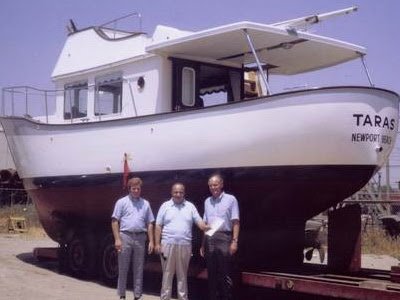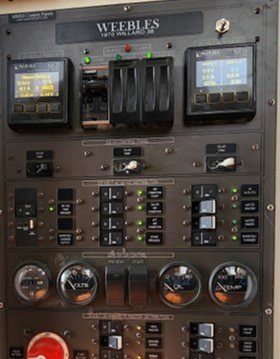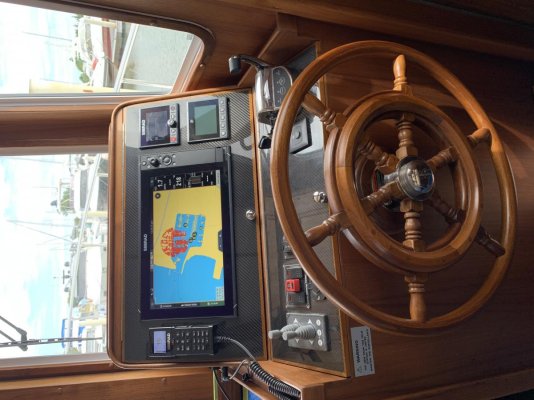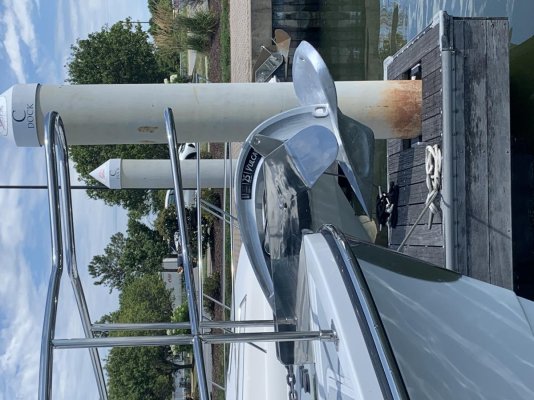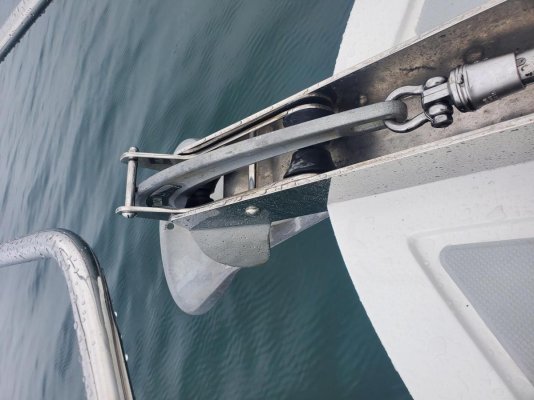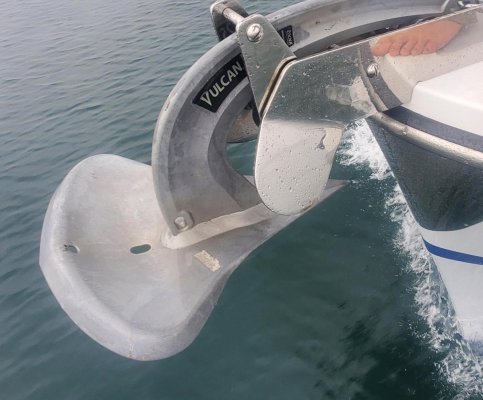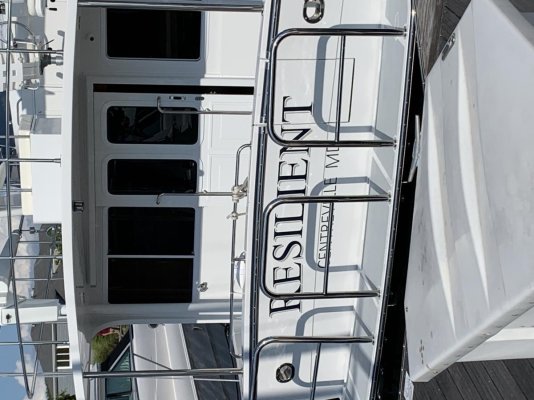When owners have chatted offline with each other, options chosen are a big topic. I dealt with that for my personal choices.
Where are you on your build, and what are you seeing is a big one. Dealt with that.
But another one is the shipping process. I'll take a crack at this.
Your beautiful new boat is done. Hooray. But now it has to be transported to the other side of the planet. That this can happen, repeatedly, and reliably is itself a marvel of modern business.
In the pics you receive during the build you might notice the hull is sitting in a metal cradle. Still in that cradle, its shrink wrapped well down into the bottom paint. NO gel coat or stainless is left exposed.
For obvious reasons, not the least of which is to keep length under 40 ft, the swim platform isn't attached at this point, the arch or mast is folded down. Stuff that can stick out, get bumped or poked, is dealt with later
The yard gets it loaded onto a barge, for transport to the shipyard in Shanghai, a day or so away. Its lifted out of the barge, and ultimately onto the ship that brings it to the US.
Sounds easy. The devil is in the details.
Container ships are used. The whole container shipping business is built around standardized container lengths and designs, and attachment points for the cranes to use. The original units were 20 ft. units, but in time 40 ft became common. In the industry these things work off of TEU's, or Twenty Foot Equivalent Unit. So a 40 ft container is 2 TEU's.
There is a gadget used for odd cargo called a "flat rack". Basically its a strong bottom, upright ends, but open on the sides and top. In Shanghai, the boat and its cradle are lifted onto a flat rack, and the flat rack is loaded onto the ship. This is a lot easier to understand when seen.
So your boat is strapped to the cradle, and cradle is strapped to a flat rack. The flat rack can then sit on top of other containers, but nothing on top of the boat.
Somewhere in the process of having been loaded and the ship underway, you will receive from Helmsman a Bill Of Lading. At this point, your boat is no longer in China or Chinese hands, but now in the legal hands of Helmsman.
The whole business of shipping is handled through specialized shipping agents. Those folks find the ships destined for the port needed, book it, and handle the needed paperwork. In the days leading up to my boat's departure the exact ship designation changed a couple of times. No worries on that, at all. No need to be surprised if it happens to you.
Helmsman will be communicating with you throughout this process. You know where you are, when the departure is expected, and the target ETA at the destination port. I can't emphasize "target" ETA enough. More on that in a moment.
Pretty much everyone is using the various online websites that track ships and shipping. Its kinda fun to know where your boat is. It helps satisfy the curiosity about the schedule to come. Your friends and family will be asking "where is she now?", and you can give the cheerful answer Panama Canal.

.
But, I urge anyone to remain patient. Remain very flexible about any plans based on arrival time.
Think about this for a moment. NONE of this timeline is controllable by Helmsman. The ship will depart when its ready. Along the way the ship can have weather related delays where they might detour around a storm a bit. The ship is likely to make a few stops between Shanghai and your destination port. For east coast deliveries transiting the Panama Canal introduces additional chances for some delay. Again, NONE of this is controllable.
Meanwhile the Helmsman team has their own plans to make to offload the ship and bring it into some marina. They are doing this for your boat, but they are running a business too, and are juggling a number of boats, not just yours.
With each passing day of shipment, the window of the ETA begins to narrow, until you get close to D day and things begin to firm up.
I'll repeat this again for emphasis: don't feel like you can make solid plans well in advance. Certainly not as it ships. Probably not until at best 2 days or so in advance of actual arrival. If you make solid plans that turn out to be premature, that's on you.
Once your ship arrives, the unloading schedule and process is at the total whim of the shipyard and its crew. The level of communication of what they plan to do, and when they plan to do it is entirely up to them.
All of this might only make sense using the example of my own boat. The ETA in Norfolk was originally estimated for June 24. Pretty quickly that moved to June 25. Meanwhile yard staff is communicating to Helmsman probable offload on June 26. On June 27 I get word its being offloaded on June 28, "sometime in the afternoon." The ship arrived in Norfolk a day or so earlier but was at anchor outside the docks until it had a slot at the docks.
I learn in this process that each port has its own rules and habits. Some are better than others in communications, and each has its rules about how it will handle offloading. Your experience may well differ.
The Helmsman team at this point has two key players. First, one guy gets aboard the ship, hours in advance. He's working with the ship crew to see your boat and hopefully find no obvious dings or damage. He's working with the crew about when to expect offloading. There are several different ways the crew can choose to lift the boat, and they talk through the options the ship crew prefers (One, lift the entire flat rack onto land, two, lift the cradle off the flat rack, and three get straps under it and lift directly into the water). In my case, Norfolk crew won't touch the shrink wrap, so it had to go to land first, then to water. They fiddled around for the longest time trying to locate the appropriate shackles for the flat rack.
So from the ship it was put ashore on the dock. The Helmsman guy aboard ship then begins to strip off shrink wrap. And then we all wait, and wait, and wait, until shipyard crew is again ready to lift it off the cradle and into the water. The cradle it began life in remains at the dock as scrap metal.
And its a flurry of activity to lift every hatch and look for any sign at all of water leaking in! Key point!
Meanwhile, other Helmsman crew has a tow boat lined up. And its floating around next to the ship for hours just waiting. And waiting. For safety reasons your boat is shipped with virtually no fuel aboard. So its lifted into the water unwrapped, but dry. The tow boat tows you to a nearby fuel dock where you take aboard a needed amount. Some water is taken on. The engines are fired up, and of course everything gets a hard initial look. Shaft seal OK? Check. That sort of thing. And from there, its about motoring to wherever it will spend the night.
In some cases, it works out that Helmsman can invite owners to attend this birthing and delivery process. I was lucky, and am grateful I had the chance. This is a very hard work day for the Helmsman crew. Its a lot of hurry up and wait, then hurry up again.
The tow boat captain is in charge of his boat, and its a work day for him, and he's unlikely to want a crowd of tourists aboard. So if you get the shot to do this, don't even think about turning this into a family picnic on a boat. When its time to spring into action, your best job is to stay out of the way while the Helmsman crew goes through quite a series of checklist things to make sure all is well and you are not sinking.
Be responsible. Bring your own life jacket.
In my case, the boat was delivered to Norfolk. For a host of reasons the plan was to motor north for two days to my home marina where commissioning would be completed.
So that said as background, lets back up a bit. I get word on a Tuesday my boat is to be unloaded on Wednesday afternoon. I drive 4 hours to Norfolk. I'm to meet Scott at a designated marina for the tow boat at noon. Off we go, and begin to float in wait for the rest of the afternoon. In the blazing sun in an open boat. By the time the boat was finally in the water it was close to sundown, we were at the fuel dock at dusk, and in a slip after dark. Scott starts prepping the boat, attaching anchor, organizing some supplies, etc. I volunteer to find a grocery store, and am hitting there close to 10pm, sprint through there and redeliver groceries to the boat. My dinner was a convenience store sandwich at 10:30 and asleep by 11.
I'll spare you the rest and the finer details. I just want to make two key points: 1) nothing about this is controllable by Helmsman, so don't expect to hear a plan and timeline. Their ability to scramble on the fly and continuously react to whatever comes is what makes this happen as well as it does. 2) it can be a LOOONG day on the water, in an open boat. Bring sunscreen. Ladies, there is no head aboard such boats, and there is no telling in advance when you will be near one. If you accept the invitation to join in this day, just know that. I accepted and my wife declined.
Its a great thing to experience if you can. Your head will spin watching the team do its thing. Sit back and watch. I wouldn't miss it.
I've had 10 days to absorb and process this. Its impressive, but wish I had a better word. Your perfectly built boat arrives at its first marina night, shipped from across the seas, and my case in flawless condition.
And you my friend will be exhausted, excited, and the head still swimming at the end of this long day.
For the Helmsman crew its another day at work, doing what they do, and doing it damned well.

